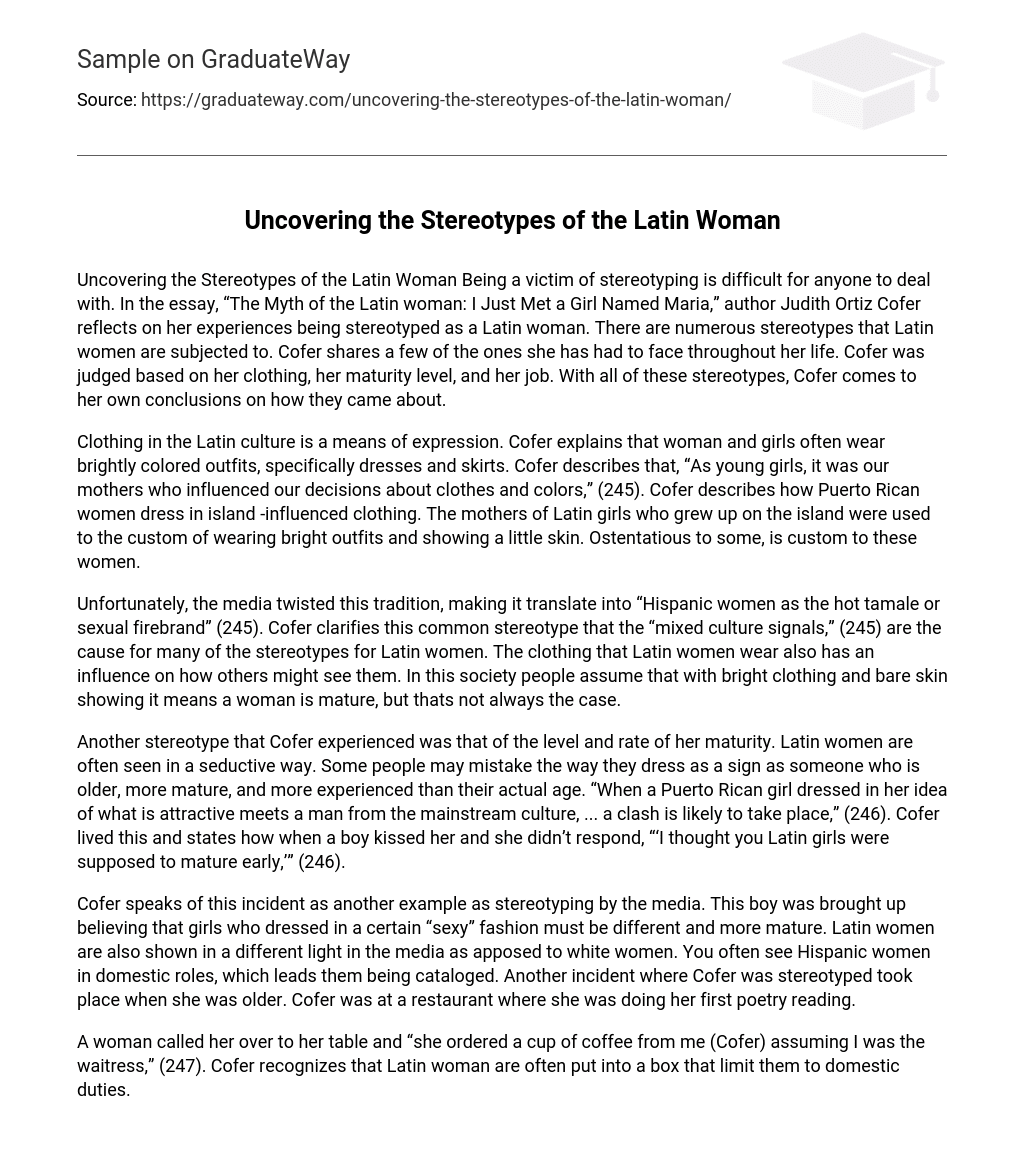Being a victim of stereotyping is difficult for anyone to deal with. In the essay, “The Myth of the Latin woman: I Just Met a Girl Named Maria,” author Judith Ortiz Cofer reflects on her experiences being stereotyped as a Latin woman. There are numerous stereotypes that Latin women are subjected to. Cofer shares a few of the ones she has had to face throughout her life. Cofer was judged based on her clothing, her maturity level, and her job. With all of these stereotypes, Cofer comes to her own conclusions on how they came about.
Clothing in the Latin culture is a means of expression. Cofer explains that woman and girls often wear brightly colored outfits, specifically dresses and skirts. Cofer describes that, “As young girls, it was our mothers who influenced our decisions about clothes and colors,”. Cofer describes how Puerto Rican women dress in island -influenced clothing. The mothers of Latin girls who grew up on the island were used to the custom of wearing bright outfits and showing a little skin. Ostentatious to some, is custom to these women.
Unfortunately, the media twisted this tradition, making it translate into “Hispanic women as the hot tamale or sexual firebrand” (245). Cofer clarifies this common stereotype that the “mixed culture signals,” (245) are the cause for many of the stereotypes for Latin women. The clothing that Latin women wear also has an influence on how others might see them. In this society people assume that with bright clothing and bare skin showing it means a woman is mature, but thats not always the case.
Another stereotype that Cofer experienced was that of the level and rate of her maturity. Latin women are often seen in a seductive way. Some people may mistake the way they dress as a sign as someone who is older, more mature, and more experienced than their actual age. “When a Puerto Rican girl dressed in her idea of what is attractive meets a man from the mainstream culture, … a clash is likely to take place,”. Cofer lived this and states how when a boy kissed her and she didn’t respond, “‘I thought you Latin girls were supposed to mature early,’”.
Cofer speaks of this incident as another example as stereotyping by the media. This boy was brought up believing that girls who dressed in a certain “sexy” fashion must be different and more mature. Latin women are also shown in a different light in the media as apposed to white women. You often see Hispanic women in domestic roles, which leads them being cataloged. Another incident where Cofer was stereotyped took place when she was older. Cofer was at a restaurant where she was doing her first poetry reading.
A woman called her over to her table and “she ordered a cup of coffee from me assuming I was the waitress,” . Cofer recognizes that Latin woman are often put into a box that limit them to domestic duties. It is a stereotype that most Latin women have jobs that are more in the service end of domestic duties, i. e. waitresses, laundresses, housekeepers. Cofer used her poetry reading as a way to show all that just because she was Latin did not mean that she was illiterate or uneducated.
In any society something that is common to one person can seem unusual to another. Because of this confusion, stereotypes and prejudice can be formed. Cofer wrote this essay “The Myth of the Latin woman: I Just Met a Girl Named Maria,” as a way to expose the ongoing stereotyping Latin woman face. Cofer analyzes her experiences and shares her opinions on why they even happened. Cofer shared how the way Latin women dress is not to be “sexy” or to attract men. The women dress like that because thats is how there mothers dressed on hot islands.
It was common to wear bright colored dress on a tropical island and not heavy clothing to stay cool. It is also a misconception that Latin girls are “fast” when it comes to their maturity. Because they are seen in an alluring way, some people maybe think they are more sexually mature. Cofer clarifies that this is not the case, Latin girls mature and grow at the same rate as any other girl. Cofer also told a story of how because of her race a woman assumed she was a waitress in a restaurant. Another way of discrimination to Latin women, that all of them have jobs in the domestic field.
Cofer really brings to light how easy it is to judge a person and use a stereotype against them. Cofer shows that if people took the time to talk and understand other cultures then all of these misunderstanding, wouldn’t be turned into stereotyping. Supporting Cofer in her efforts to stop this stereotyping from happening could make a big difference in how everyone will treat each other.





